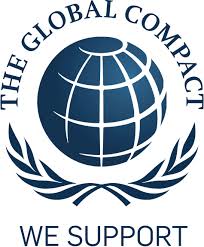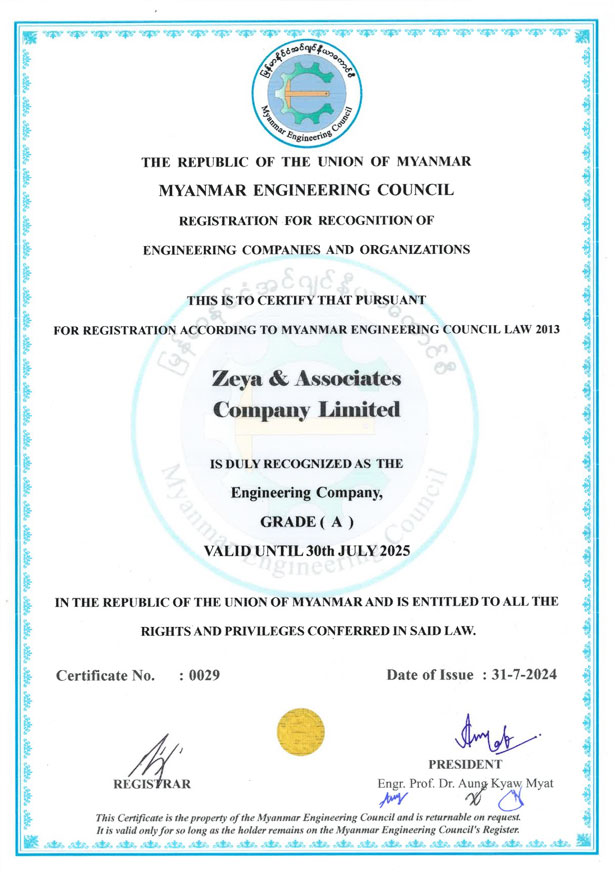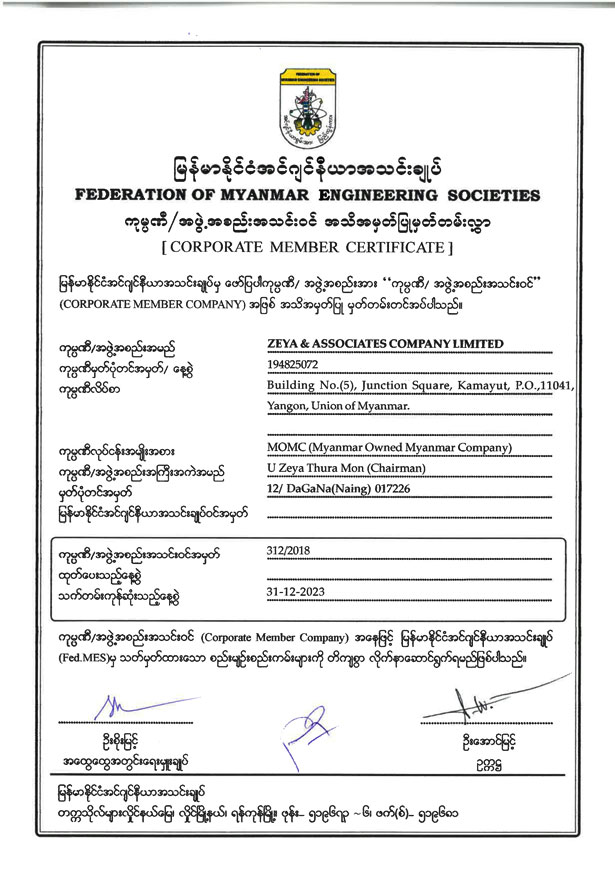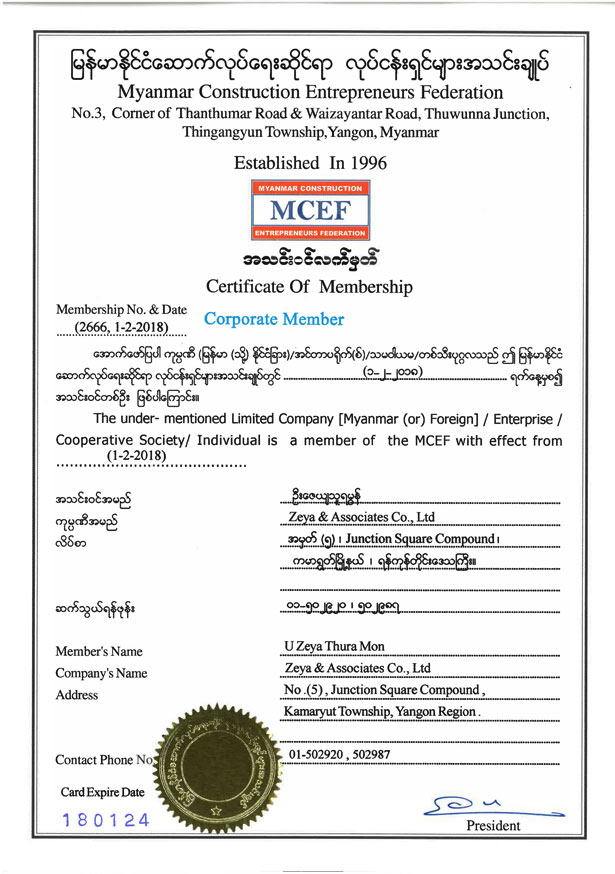Awards and Recognition
Zeya & Associates Co., Ltd. has been assessed and certified as meeting the requirements of ISO 9001:2015 for the following activities:
The Provision of Engineering, Procurement and Contracting (EPC) for Electrical Power Systems and Heating, Ventilation, Air Conditioning and Refrigeration Systems (HVAC&R), Sales, Marketing, Service and Showroom Management for HVAC&R Systems and Power Systems. Trading of Medical Devices.
Overview of the UN Global Compact
 The UN Global Compact is a strategic policy initiative for businesses that are committed to aligning their operations and strategies with ten universally accepted principles in the areas of human rights, labour, environment and anti-corruption. By doing so, business, as a primary driver of globalization, can help ensure that markets, commerce, technology and finance advance in ways that benefit economies and societies everywhere.
The UN Global Compact is a strategic policy initiative for businesses that are committed to aligning their operations and strategies with ten universally accepted principles in the areas of human rights, labour, environment and anti-corruption. By doing so, business, as a primary driver of globalization, can help ensure that markets, commerce, technology and finance advance in ways that benefit economies and societies everywhere.
As social, political and economic challenges (and opportunities) — whether occurring at home or in other regions — affect business more than ever before, many companies recognize the need to collaborate and partner with governments, civil society, labour and the United Nations.
This ever-increasing understanding is reflected in the Global Compact's rapid growth. With over 12,000 corporate participants and other stakeholders from over 145 countries, it is the largest voluntary corporate responsibility initiative in the world.
Endorsed by chief executives, the Global Compact is a practical framework for the development, implementation, and disclosure of sustainability policies and practices, offering participants a wide spectrum of workstreams, management tools and resources — all designed to help advance sustainable business models and markets. (See How to Participate.)
The UN Global Compact works toward the vision of a sustainable and inclusive global economy which delivers lasting benefits to people, communities, and markets.
To help realize this vision, the initiative seeks to:
1. Mainstream the Global Compact’s Ten Principles in business strategy and operations around the world; and
2. Catalyze business action in support of UN goals and issues, with emphasis on collaboration and collective action.
With these objectives in mind, the Global Compact has shaped an initiative that provides collaborative solutions to the most fundamental challenges facing both business and society. The initiative seeks to combine the best properties of the UN, such as moral authority and convening power, with the private sector’s solution-finding strengths, and the expertise and capacities of a range of key stakeholders. The Global Compact is global and local; private and public; voluntary yet accountable.
The benefits of engagement include the following:
 Adopting an established and globally recognized policy framework for the development, implementation, and disclosure of environmental, social, and governance policies and practices.
Adopting an established and globally recognized policy framework for the development, implementation, and disclosure of environmental, social, and governance policies and practices.
 Sharing best and emerging practices to advance practical solutions and strategies to common challenges.
Sharing best and emerging practices to advance practical solutions and strategies to common challenges.
 Advancing sustainability solutions in partnership with a range of stakeholders, including UN agencies, governments, civil society, labour, and other non-business interests.
Advancing sustainability solutions in partnership with a range of stakeholders, including UN agencies, governments, civil society, labour, and other non-business interests.
 Linking business units and subsidiaries across the value chain with the Global Compact's Local Networks around the world — many of these in developing and emerging markets.
Linking business units and subsidiaries across the value chain with the Global Compact's Local Networks around the world — many of these in developing and emerging markets.
 Accessing the United Nations' extensive knowledge of and experience with sustainability and development issues.
Accessing the United Nations' extensive knowledge of and experience with sustainability and development issues.
 Utilizing UN Global Compact management tools and resources, and the opportunity to engage in specialized workstreams in the environmental, social and governance realms.
Utilizing UN Global Compact management tools and resources, and the opportunity to engage in specialized workstreams in the environmental, social and governance realms.
A more detailed analysis of the benefits of participation in the Global Compact can be found in The Importance of Voluntarism — which also focuses on the importance of the Global Compact as a complement rather than substitute for regulatory regimes
Finally, the Global Compact incorporates a transparency and accountability policy known as the Communication on Progress (COP). The annual posting of a COP is an important demonstration of a participant's commitment to the UN Global Compact and its principles. Participating companies are required to follow this policy, as a commitment to transparency and disclosure is critical to the success of the initiative. Failure to communicate will result in a change in participant status and possible expulsion.
In summary, the Global Compact exists to assist the private sector in the management of increasingly complex risks and opportunities in the environmental, social and governance realms, seeking to embed markets and societies with universal principles and values for the benefit of all.
Partnership with Rolls-Royce
 RGK+Z&A signed a long-term service agreement with Rolls-Royce for spare parts supply, supervision and maintenance for the Hlagwa Power Plant (Phase II) project today. The agreement was signed at the Foreign & Commonwealth Office in London by Lars Eikeland, President and CEO of Bergen Engines, and Mr Zeya Thura Mon, Group CEO of RGK+Z&A Group & Managing Director of Zeya & Associates; and witnessed by Hugo Swire, Minister of State at the Foreign & Commonwealth Office, and His Excellency Mr U Khin Maung Soe, Minister of Electric Power (MOEP), The Republic of the Union of Myanmar.
RGK+Z&A signed a long-term service agreement with Rolls-Royce for spare parts supply, supervision and maintenance for the Hlagwa Power Plant (Phase II) project today. The agreement was signed at the Foreign & Commonwealth Office in London by Lars Eikeland, President and CEO of Bergen Engines, and Mr Zeya Thura Mon, Group CEO of RGK+Z&A Group & Managing Director of Zeya & Associates; and witnessed by Hugo Swire, Minister of State at the Foreign & Commonwealth Office, and His Excellency Mr U Khin Maung Soe, Minister of Electric Power (MOEP), The Republic of the Union of Myanmar.
Earlier this year, Bergen Engines, part of Rolls-Royce Power Systems (RRPS), signed a contract with RGK+Z&A Group of Myanmar for delivery of engines and associated systems for Phase II of the country's first medium speed gas engine-based power plant, the Hlagwa Power Plant.
The Hlawga Power Plant, located in Yangon near the Hlawga CCPP and Main Substation of MEPE, is a gas engine-based Independent Power Plant (IPP) owned by RGK+Z&A Group. It will deliver power to the Yangon grid and the contract stipulates a capacity of 25 MW. A Power Purchase Agreement (PPA) and other related agreements for the power plant have already been concluded by RGK+Z&A Group with MOEP.
RGK+Z&A Group is an engineering company based in Myanmar which focuses on the thermal power generation, green energy, transmission and distribution industries. The Hlawga Power Plant (Phase I) was built last year using high speed engines and was the first plant to conclude a PPA with MOEP.
"We are excited to be a partner in further developing the electrification of Myanmar," said Lars Eikeland, at the ceremony. "Z&A is a very competent partner and we are confident that this will be a successful project. We are also very pleased that this project could be financed by loan facilities from GIEK, the Norwegian Exoprt Credit Agency."
"We are committed to provide uninterrupted electricity to Myanmar by Power Generation with minimum resources. We believe that with the state of art solutions from Rolls-Royce Power Systems, we could achieve more output to deliver the Power needs", said Zeya Thura Mon.
The energy infrastructure in Myanmar is still developing. The country's electrification rate is 26% and demand is expected to grow rapidly. Annual growth of 15% is projected. Gas is available in centres of electricity demand and can be the source of more environmentally friendly power through the use of high efficiency gas engines.
The new power plant will be the first medium speed gas engine based power plant in the country. The contract scope includes the supply of three B35:40V20 gas engines plus complete system engineering.
About Rolls-Royce Holdings plc
Rolls-Royce's vision is to create better power for a changing world via two main business segments, Aerospace and Marine & Industrial Power Systems (MIPS). These business segments address markets with two strong technology platforms, gas turbines and reciprocating engines, for use on land, at sea and in the air.
Aerospace comprises Civil Aerospace and Defence Aerospace. MIPS comprises Marine, Energy & Nuclear and Power Systems (RRPS). On 7 March 2014, Daimler announced their intention to exercise their option to sell their 50% share in RRPS to Rolls-Royce Holdings plc. On 16 April 2014, the valuation was agreed and the transaction is expected to complete within the coming months, subject to the usual regulatory approvals. On 6 May 2014 Rolls-Royce announced it had signed an agreement to sell its Energy gas turbine and compressor business to Siemens for a £785m cash consideration. On completion, expected before the end of December 2014, Rolls-Royce will receive a further £200 million for a 25 year licensing agreement.
Rolls-Royce has customers in more than 120 countries, comprising more than 380 airlines and leasing customers, 160 armed forces, 4,000 marine customers, including 70 navies, and 1,600 energy and nuclear customers.
Our business is focused on the 4Cs:
 Customer - placing the customer at the heart of our business
Customer - placing the customer at the heart of our business
 Concentration - deciding where to grow and where not to
Concentration - deciding where to grow and where not to
 Cost - continually looking to increase efficiency
Cost - continually looking to increase efficiency
 Cash - improving financial performance.
Cash - improving financial performance.
Annual underlying revenue was £15.5 billion in 2013, around half of which came from the provision of aftermarket services. The firm and announced order book stood at £71.6 billion at 31 December 2013.
In 2013, Rolls-Royce invested £1.1 billion on research and development. We also support a global network of 31 University Technology Centres, which position Rolls-Royce engineers with the forefront of scientific research.
Rolls-Royce employs over 55,000 people in 45 countries. Over 17,000 of these are engineers.
The Group has a strong commitment to apprentice and graduate recruitment and to further developing employee skills. In 2013 we employed 379 graduates and 288 apprentices through our worldwide training programmes.
About Bergen Engines, a Rolls-Royce Power Systems company
Bergen Engines produces gas and diesel engines for land and marine power systems. Since its foundation in 1946, Bergen Engines has produced 6,500 medium speed engines of which 4 000 are still in operation. Bergen Engines has its headquarters, technology development and manufacturing facilities in Norway and has delivered engines for land power applications for nearly 20 years. These can range up to 9.4MW unit size. Bergen Engines has power installations across the world. In Bangladesh, for instance, facilities powered by Bergen Engines deliver approximately 14% of the country’s electrical supply.
About RGK+Z&A Group
The vision of RGK+Z&A Group is to develop a portfolio of generating assets with a capacity of 500 MW supported by a strong EPC and Operations & Maintenance team. The target for the group in power generation is to develop around 100 MW of generation capacity based on natural gas by end of 2015. Beyond this stage, the company would explore generation projects - gas fired as well as renewable sources including Municipal Waste to Energy, wind and solar.
Over the long term, the company plans to be publicly listed in the upcoming Myanmar Stock Exchange and raise capital for larger projects.
For further information, please contact:
Erin Atan
Head of Communications, Asia & Pacific
Rolls-Royce plc
Tel: +65 6501 7600
Mob: +65 9068 8639
Email: [email protected]
Stephanie Watters
External Communications Manager
Rolls-Royce plc
T: +44 (0)20 7227 9140
M: +44 (0)78 2460 7328
E: [email protected]
MEC ZNA Grade (A) up to 30 July 2025 RGKZNA is duly recognized as The Engineering Company GRADE (A) by Myanmar Engineering Council. RGKZNA started joining the Myanmar Engineering Council in April 2018. |
Federation of Myanmar Engineering Society (MES) Zeya & Associates is one of the Corporate Members – CMC of Federation of Myanmar Engineering Society (MES) |
Myanmar Construction Entrepreneurs’ Federation (MCEF) Zeya & Associates has been a Corporate Member of Myanmar Construction Entrepreneurs’ Federation (MCEF) since February 2018. |
|
















